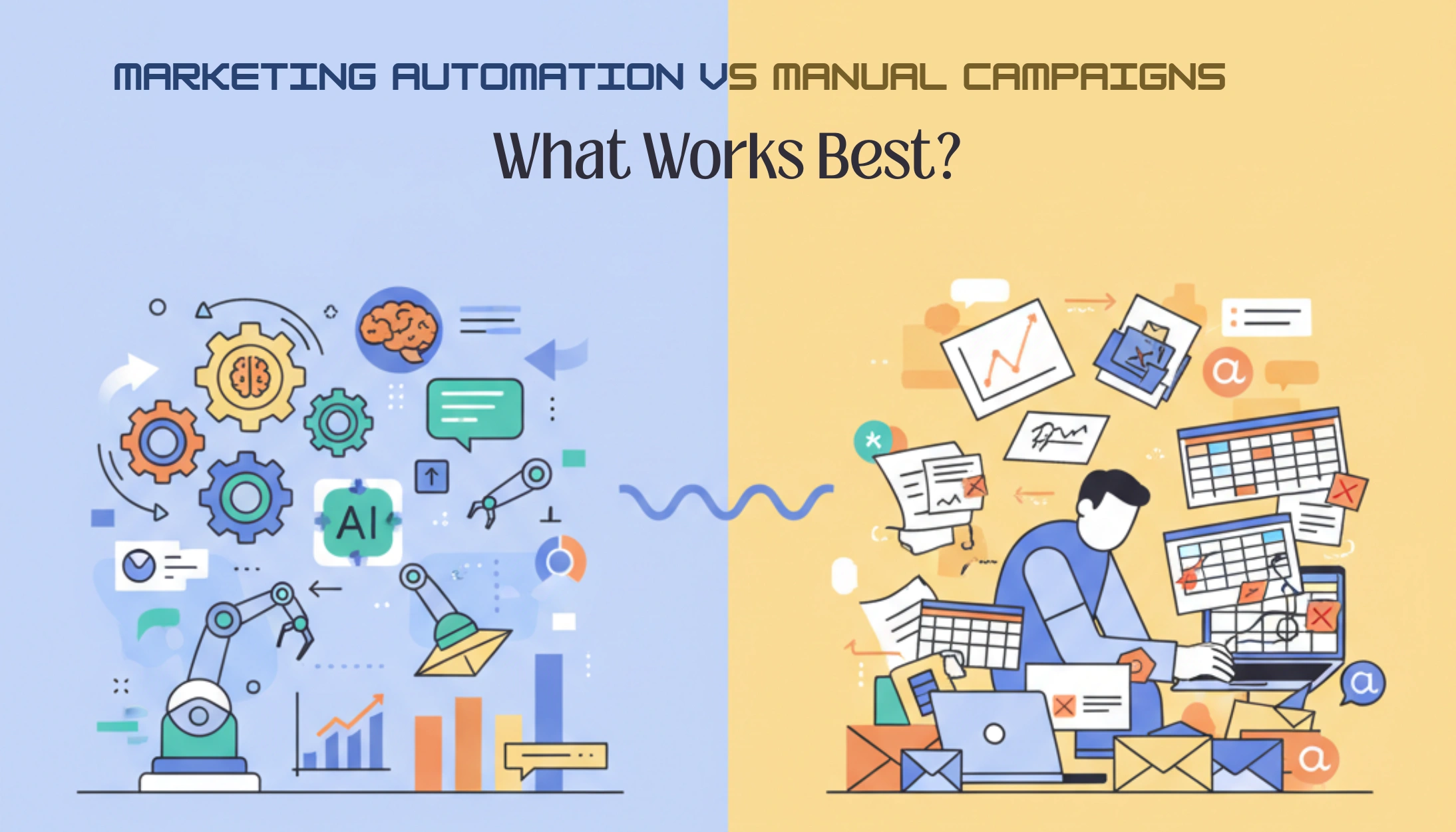No doubt, automation expedites many processes that used to take hours and even days. But is it ok to completely rely on it? If there are a lot of things you can automate for digital marketing, there are also many things that can only be handled manually. However, achieving 100% automation is currently challenging, but it is in progress, and the results can vary as well. So, what is better, marketing automation or a manual campaign? The decision is yours, but we can help you make the right one.
We have highlighted crucial points about automation and manual campaigns. You can explore them and decide which one is more likely to go with your next marketing strategy. Do not struggle and take too long to land on a choice because quick and right decisions matter more than ever now.
What Is Marketing Automation?
Let’s first understand what marketing automation is. You can manage multiple marketing tasks without relying on humans with the help of software and IoT. It automates several tasks that would otherwise take many days to complete. These tasks include sending emails, posting on social media, tracking website visits, and managing customer data.
You do not have to write an email manually; software can do it for you. You will not have to send emails every day; the software will automatically schedule them. Likewise, you will not have to analyze the results, as this software can also do so. It provides a comprehensive report of the performance. You can integrate popular tools like HubSpot, Mailchimp, ActiveCampaign, and many others into your system and enjoy the era of automation.
What Is a Manual Campaign?
When you complete all the tasks discussed above manually, it’s referred to as manual handling of the marketing campaign. However, a manual campaign requires more time, and the risk of mistakes is also higher. But relying completely on software and machines is also risky. The human touch in the process improves reliability, and if anything surprising happens, humans can take responsibility. Software can’t be accountable.
You can handle all marketing activities by yourself or with a team. So, manual work gives more control, but it also demands more time and effort.
Benefits of Marketing Automation
We will walk you through the benefits of automation. Some benefits have been so groundbreaking that several businesses have integrated automation into their processes, Although integration can’t be done entirely because there are some drawbacks also. We have covered benefits in the space below; have a look.
1. Finish Tasks Quicker
The main reason many digital marketers use automation is to save time. The Internet of Things, integrated with advanced technologies and AI, completes tasks in milliseconds. Many apps handle various marketing tasks more efficiently and quickly than humans. Automation saves hours of work. Once you set it up, the system runs on its own.
2. Scales Easily
To achieve one conversion, various digital marketing strategies are employed. Your entire team must plan how to achieve goals and meet the requirements. They have to do many repetitive tasks. They often struggle when traffic increases. It brings more work and responsibilities, but not enough time. You can handle a large number of customers without extra effort. Whether it’s 100 or 10,000 people, automation can manage it.
3. Makes Data-Driven Decisions
Tools can store and manage a large amount of data simultaneously. They can process all the data simultaneously and analyze it to produce reports. It helps marketers make crucial decisions, such as when to launch a new product or service, what the impact of the new product will be, and whether it will be beneficial or not.
Marketers analyze the report to predict whether they will have good sales this month, what the optimal time to launch a new product is, and many other factors. They can make decisions in a few minutes that they would have struggled with without data analysis. Moreover, with the help of data analysis, you can see who opens your emails, clicks links, or visits your site.
4. Consistent Results
Automation in marketing ensures consistency in work. For example, if you are busy and can’t upload YouTube Shorts or a TikTok video for the next three days, schedule them. Even if you are not uploading the videos manually, your audience will still have access to your content daily. Similarly, with social media posts, just create them in advance and schedule them using a popular platform like Hootsuite, among others. It keeps your brand consistent.
5. Better Lead Nurturing
Lead nurturing is a lengthy process that includes careful consideration to achieve better conversions. Automation has also made this process easy and quick. You can create drip campaigns that automatically guide a lead through the customer journey.
Drawbacks of Automation in Marketing
Is everything good about automation? No. Automation does have drawbacks. We have listed them below so you can review them before making a final decision.
1. Expensive Tools
Technology is expensive. Many good automation tools come with monthly fees because they require talent, precision, and accurate infrastructure to develop software. So, it can be costly for small businesses to integrate a tool backed with advanced technology.
2. Lack of Personal Touch
No matter how advanced the tool you use, human approval is still required. Likewise, human touch makes emails relevant and emotional. Audiences connect more effectively with humans than robots. Automation lacks the warmth of a manually written message.
3. Learning Curve
Tools and apps have their own interfaces and features that can seem intimidating at first. Your team might struggle to understand how to use the new marketing tools. Setting up the system and understanding how it works takes time.
4. Not Always Accurate
If your data is wrong, the system will send the wrong message to the wrong people. Here, human consciousness matters because humans can spot errors regardless of standardized rules.
Benefits of Manual Campaigns
When automation can save time and deliver results accurately and consistently, why do some people still rely on manual marketing campaigns? Often, you struggle to find the answer to it. Let’s examine the reasons why many companies continue to rely on manual campaigns.
1. Full Control
You have full control, not software, in manual campaigns. Since humans can think and make decisions based on current situations, machines fail because they only respond according to set rules and algorithms. You know what’s going out, when, and to whom. So you can change your campaign instantly.
2. More Personal
Software writes the same types of messages for all, which sounds robotic. Although today, with the help of ChatGPT and other generative tools, you can edit and personalize emails, it still requires the human touch. Since you are doing it yourself, you can tailor messages specifically for the person or business.
3. Perfect for Small Campaigns
When you are starting a small business, integrating tools can be expensive. It’s because automation is suitable when there are a lot of tasks and processes, and managing them manually is time-consuming. Handling such a big team and running campaigns worldwide can be overwhelming; here, automation provides better ROI. But when you run small campaigns, handle digital marketing tasks manually because it will give you full control, and you can also control unnecessary expenses.
4. Easy to Start
Manual campaigns are easy to start because you need fewer prerequisites, like learning a tool. You can start straight from the current tool. There is no need to first train your team on the AI-driven software and then implement it; they can start immediately. However, nowadays, 100% manual campaigns are not possible, so tools handle some percent of the campaign.
Drawbacks of Manual Campaigns
Manual campaigns provide you with full control, but they also have some drawbacks. Know them so you can create a better digital marketing strategy, considering possible problems.
1. Time-Consuming
Doing everything by hand takes a lot of time and effort. Nowadays, you have to run campaigns quickly, and that is on time. In the era of trends and viral reels, if you get late to follow the trend, you might miss the reach. If not done on time, it makes no sense.
2. Hard to Scale
As your business grows, it becomes difficult to manage everything manually. Automation fits best when you have a lot of tasks, reduce the chances of errors, and scale with a growing business.
3. Prone to Errors
You must have heard and read the term “To err is human”. You might forget to send an email, schedule a post, or follow up on a lead.
4. Inconsistent
You may forget to email or skip for a few days, or you may not manage the same tone. This is all lead to inconsistency. Automation provides consistency for all tasks and maintains the brand voice.
We have learned the pros and cons of automation in marketing and manual marketing. Now you must have understood that picking any one straightforward is not easy. You need to consider some factors to choose one or go for a combination of both. We have tried to help you decide in the section below.
When to Use Marketing Automation?
Here are some situations in which you can choose marketing automation.
- When you have a large customer base
- When you run long-term campaigns
- When you need to send regular emails or posts
- When you want to track user behavior
- When you need detailed analytics
When to Use Manual Campaigns?
Understand, in which situations you should go with manual campaigns. Here are the points to help you.
- When you are just starting out
- When the campaign is short-term
- When you want to send personalized messages
- When your audience is small
- When you are testing something new
What About Blending Both for Best Results?
The truth is, you don’t have to choose only one. The best marketers use a mix of both.
- Use automation to schedule emails, manage leads, and track actions.
- Use manual efforts for high-value clients, custom messages, or quick adjustments.
For example, you can automate your weekly newsletter. But manually follow up with someone who replied.
What It All Means
Marketing automation and manual campaigns both have their place. Automation is fast, scalable, and ideal for repetitive tasks, while manual efforts provide control and a personal touch. You don’t need to pick one over the other; the best approach is to use both based on your goals, team size, and customer needs.
So, start small, test what works, and build a smart mix of automation and manual work. That way, you will get the speed of software with the heart of human connection.
In the end, it’s not about choosing sides; it’s about choosing what works best for you.










